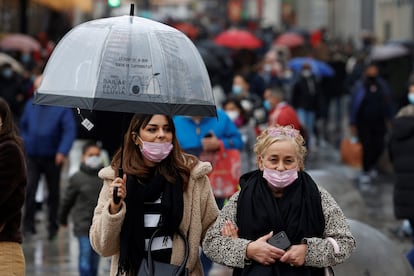Official statistics suggest sixth coronavirus wave in Spain is starting to slow
While the curve is still rising, the increase in the cumulative incidence has gone from 90% weekly growth during the Christmas holidays to 17% on Friday

The sixth wave of the coronavirus in Spain is starting to show the first symptoms of slowing down. After explosive growth during the Christmas holiday season, the latest data from the central Health Ministry shows a more gradual rise, suggesting that a peak may be imminent.
Last week saw new records set for the pandemic: there were 179,125 official infections reported in a single day, and if infections continue to grow, albeit on a slower scale, this number could get even higher. But the cumulative incidence is no longer rising so sharply.
According to the latest ministry report, which was released on Friday, the 14-day cumulative incidence currently stands at 3,196 cases per 100,000 inhabitants, having risen 36 points from Thursday. That said, this trend is based on incomplete data: there are notification delays to bear in mind, as well as the fact that many people are using home antigen kits to confirm their infections – cases that often do not get included in the official statistics. This means that the ministry data only shows the tip of the iceberg in terms of what is really happening.
The slowdown in the official figures, however, is clear to see. During the last week of December and the first week of January, the 14-day incidence was growing more than 90% on a weekly basis, while on this past Friday, that figure was 17%. The 29-point rise seen on Thursday and the 36-point rise on Friday are in contrast to spikes that were in excess of 100 points from December 22, with a maximum of 267 points in a single day on December 29.
Do these data offer a genuine picture of what is happening in Spain? They are clearly providing an incomplete and tardy snapshot – what is unclear is to what extent. Tardy because more than a week can pass between the onset of symptoms and a coronavirus test, assuming that one is carried out at all. And as mentioned, home testing means that many cases are not included in the statistics.
It’s very difficult to know what part of the reduction in cases is a possible real fall in transmission and which part is a fall in detectionEpidemiologist Salvador Peiró
What’s more, there are currently no clear criteria as to how to deal with these results. Some regions, such as Galicia, Navarre, Catalonia and Aragón, report home kit results to the Health Ministry, but others, such as Murcia, Andalusia, Madrid, the Balearic Islands, Castilla y León and Valencia, require an additional test to confirm them. The Basque Country, which was reporting these results, stopped doing so last week.
The consequences of this are untrustworthy statistics that vary greatly from region to region, with a cumulative incidence, for example, of 6,594 cases per 100,000 inhabitants in the last 14 days in Navarre, compared to 1,419 in Andalusia. The percentage of this figure that corresponds to real cases and that of underreporting remains a mystery. In places such as Aragón, roughly half of notified cases correspond to home tests, many of which are under the radar in regions where PCR confirmation is required.
“It’s very difficult to know what part of the (still questionable) reduction in cases is a possible real fall in transmission and which part is a fall in detection,” explains Salvador Peiró, an epidemiologist and head of research at the Fisabio research foundation in Valencia. “I suspect that in some places like Navarre, which carries out a lot of tests and is showing spectacular levels of transmission, if notified cases fall it is due to a fall in transmission (they must have ever fewer people susceptible, either due to having had an infection or due to the third dose). In other places, the component of reducing testing is likely more important.”
Navarre has, in fact, begun to show a clear fall in its 14-day cumulative incidence: of 659 points. If this trend continues, it would appear that the sixth wave has peaked in a region that was ahead of others in terms of infections. It’s not the only one to fall, and could pave the way for others that are yet to do so.
The slowdown reflected in the statistics is the prior step to reaching a peak in the cumulative incidence, something that the majority of experts consulted by EL PAÍS predicted for the middle of this month. While the majority of the waves in Spain so far had clear rises and falls, this was not always the rule. The second wave, for example, showed a fall in cases from the end of September 2020, when it reached a cumulative incidence of 294 cases; it then fell to 207 on October 7, and from there, began to rise again to reach 529 at the start of November. As shown by this example, the falls do not have to be definitive.
This has also been seen in some countries that appeared to reach a peak but then saw rises once more. This happened, for example, in Germany and the Netherlands, which are seeing rising cases now after a fall that was registered at the start of the year. In these cases, however, a variety of factors could be at work: when they were recovering from their previous wave of the delta variant, the more-contagious omicron strain arrived prompting a new spike.
This also happened in South Africa, the first country where omicron spread, prompting a sharp spike and then an equally rapid fall. The health authorities are expecting the same thing to happen in Spain once the peak is reached.
This has been going on for two years and is getting very tough on a professional level. It’s a very difficult situation all over againICU doctor Isabel Jiménez, from the Hospital Universitario in Navarre
Even if detected infections start to fall, a huge number of cases are still being notified right now – many more than those seen in previous waves, when the cumulative incidence never exceeded a thousand. The big difference now is the unprecedented levels of vaccination, with more than 90% of the population over the age of 12 fully protected. This is preventing hospitals from becoming completely overwhelmed.
Intensive care units (ICUs) in Spain are, however, practically full right now. Before the pandemic, there were 4,447 ICU beds, and on Friday there were more than 5,300 ICU patients being treated – of whom 2,224 have Covid-19, according to the ministry report.
The pressure varies from region to region, but right now the Basque Country, Navarre, Aragón and Catalonia are all under very high pressure, prompting suspensions of non-urgent surgeries.
ICU doctor Isabel Jiménez, from the Hospital Universitario in Navarre, adds that the high number of patients is being compounded by staff off sick with Covid-19. “In general we are very tired,” she explains. “Very tired of the situation because this has been going on for two years and this is getting very tough on a professional level, and there are a lot of staff off sick. It’s a very difficult situation all over again.”
No one can cover these ICU staff. “We stand in for each other, because there’s no other option,” she explains. “The problem with ICUs is that we are specialists in a minority.”
While the situation in many Spanish hospitals remains tense, and patient numbers exceed those seen in the fourth and fifth waves, in general terms they are far from the worst moments of the pandemic. In the third wave, in January 2021, there was double the number of ICU patients in Spain.
Tu suscripción se está usando en otro dispositivo
¿Quieres añadir otro usuario a tu suscripción?
Si continúas leyendo en este dispositivo, no se podrá leer en el otro.
FlechaTu suscripción se está usando en otro dispositivo y solo puedes acceder a EL PAÍS desde un dispositivo a la vez.
Si quieres compartir tu cuenta, cambia tu suscripción a la modalidad Premium, así podrás añadir otro usuario. Cada uno accederá con su propia cuenta de email, lo que os permitirá personalizar vuestra experiencia en EL PAÍS.
¿Tienes una suscripción de empresa? Accede aquí para contratar más cuentas.
En el caso de no saber quién está usando tu cuenta, te recomendamos cambiar tu contraseña aquí.
Si decides continuar compartiendo tu cuenta, este mensaje se mostrará en tu dispositivo y en el de la otra persona que está usando tu cuenta de forma indefinida, afectando a tu experiencia de lectura. Puedes consultar aquí los términos y condiciones de la suscripción digital.
More information
Últimas noticias
Most viewed
- Reinhard Genzel, Nobel laureate in physics: ‘One-minute videos will never give you the truth’
- Oona Chaplin: ‘I told James Cameron that I was living in a treehouse and starting a permaculture project with a friend’
- Pablo Escobar’s hippos: A serious environmental problem, 40 years on
- Why we lost the habit of sleeping in two segments and how that changed our sense of time
- Chevy Chase, the beloved comedian who was a monster off camera: ‘Not everyone hated him, just the people who’ve worked with him’










































